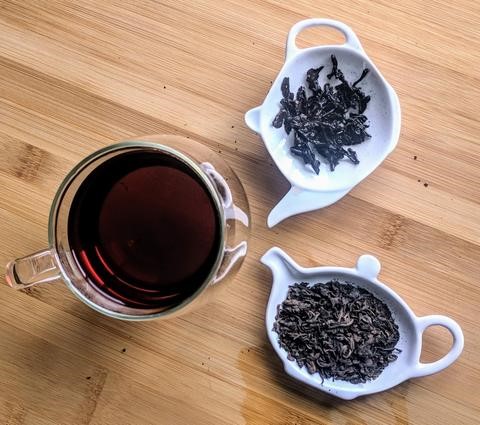We’re learning about the 5 basic types of tea, white, yellow, green, oolong, black and pu’erh. That’s 6!? Must have lost count somewhere! Let’s briefly describe each of these 6 basic tea types.

White tea
The white tea is the rarest and most exotic tea. It comes from the finest and youngest shoots of the Camellia sinensis plant. It is handpicked at the beginning of the season and the leaves or shoots used to brew this tea are very fine, silvery haired, almost fuzzy. The origin of this tea is from the Fujian province in China but can also be found from Sri Lanka, Kenya and the Darjeeling region of India. The leaves, once picked, are sun dried, gently steamed, oven dried at a low temperature of about 40C to remove all the water content and prevent oxidation. The flavour of the white tea is smooth, light and peachy, almost buttery with a slight sweetness. More can be found on White tea in a previous post.
Yellow tea
Yellow tea is another rare tea and not easy to find. Its origins are in Anhui and Hunan provinces in China. The process for making yellow tea is similar to that for green tea except that there is a longer drying process. The moist leaves are left to try until they eventually become yellow. The idea of the longer drying time is to lose the grassy, vegetative flavour that would normally be found in a green tea. I have yet to try one.

Green tea
Green teas are processed more than a white tea but does not undergo the oxidation process. The leaves are plucked, withered for a few hours then either steamed or pan-fried. The steaming or pan-frying removes the moisture from the leaves stopping the oxidation process. Think of broccoli either being steamed or fried when you’re cooking it. It seems the pan-frying method of ceasing the oxidation process is primarily done in China while the steaming process is done in Japan. As a result the flavour of green tea differs on whether it has been steamed or pan-fried. The steamed green teas of Japan have a more grassy, vegetative almost seaweed quality to them while the pan-fried green teas of China have a peachy, chocolatey flavour and the pan-fried green teas of Taiwan have a more smoky flavour.

Oolong tea
Oolong tea is also known as a semi-oxidized tea. When oolong tea is picked from the plant it is picked as unit of 1 bud and 3 leaves.
Oolong = 1 bud + 3 leaves
This 1 bud and 3 leaves groupings are exposed to the sun, drying it out slightly, and then it is dried indoors to promote oxidation. When the oxidation process is stopped is the crucial part of oolong teas and the flavour will depend largely on this. Oolong teas are usually oxidized to 20%-80% oxidation. At this point the leaves are rubbed together to create the flavour, aroma and texture of the leaf. Then the leaf is dried. Flavours of oolong teas can range anywhere from soft, floral and peachy to fuller, toasty and nutty, again, all depending on how long the leaves have been oxidized – less oxidized, softer more floral taste; more oxidation, fuller, toasty, nutty flavour.

Black Tea
Majority of the tea consumed in the west is black tea. Black teas are grown in all parts of the world, Kenya, Darjeeling and Assam India. First the leaves are exposed to hot air for several hours to reduce the water content by 50%-60%. This starts to free up the enzymes for oxidation and softens the leaves. The leaves are then rolled allowing essential oils to spread and permeate. The aroma of the black depends on the essential oils so is dependent on this rolling process. A screen is then used to separate the tea, that is the smallest leaves go onto the next stage while larger and tougher leaves undergo a second rolling. Black teas are the only tea that undergoes full oxidation. Oxidation is the chemic al reaction of the leaves and it’s components with air, humidity and heat. The leaves are then fired in ovens to stop the oxidation process. The taste of a black tea depends on many factors including where it is grown. In general it has a honey flavour and has a slight astringent flavour.

Pu’erh Tea
This is a large leaf tea variety. It is grown and picked throughout the year, not just at certain times as are many of the teas described above. There are two types of pu’erh teas. Raw pu’erh (sheng) and cooked pu’her (shu)
Raw pu’erh (Shen)
Raw pu’erh (shen) is a milder tasting tea that is more green in character, colour and flavour. The leaves are picked, sundried and compressed allowing natural aging process to occur.
Cooked pu’erh (Shu)
Cooked pu’erh (shu) is picked, processed and partially fired allowing leaves to retain their moisture. The moist tea is then put into a pile. The natural bacteria on the leaves create a reaction similar to that of a compost pile.
The tea is then aged in special caves. Pu’erh teas can be aged from 18 months up to 10 years. They are usually aged in “cakes”, where the leaves are all compressed. This is the fermentation process. The flavour of a pu’erh is earthy, toasty, almost a mushroom tasting. The raw pu’erh has a lighter, grassier flavour while the cooked pu’erh has amore full bodied, earthy flavour.
Reference
Tea 101, Academy of Tea, URL: https://academyoftea.org/tea101/
- Everyone will love this hazelnut spread stuffed cookies recipe - November 18, 2024
- The Greely Good Market is a Modern Outdoor Market - September 3, 2024
- Our Quick Visit to the Petawawa Container Market - September 3, 2024











